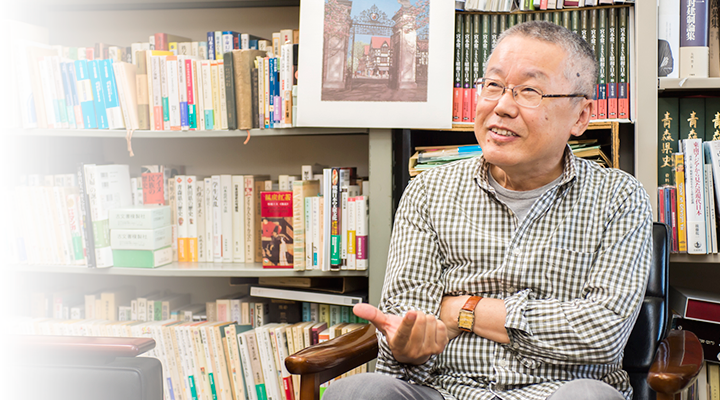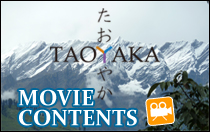
INTERVIEW
From the modern history of the Tohoku region, to the formation of
Japanese society and the reason for the rise of disadvantaged areas.
How were disadvantaged
areas born?
Exploring the hidden
possibilities of areas.
Graduate School of Letters
Prof.(Special Appointment) Hidemichi Kawanishi
From the modern history of the Tohoku region, to the formation of
Japanese society and the reason for the rise of disadvantaged areas.
As ‘Japan’s homeland’, how has the image of Tohoku been created?

Professor Kawanishi’s area of specialty is modern Japanese history. In particular, he focuses on the modern history of the Tohoku region. He says, “People tend to emphasize that, economically speaking, Tohoku is an underdeveloped area, and perhaps culturally lagging. But I wondered if that was really the case. I wanted to know how people came to have that image of the area. So I’m a researching it from that standpoint.”
The recent Great East Japan Earthquake on March 11th 2011, was something that actively forced a revision of Japanese history. With awareness of this problem and how it may affect future historical research, he decided to tackle the subject of Tohoku.

“For example people from Tohoku are simple and honest yet taciturn, and they persistently work hard. How has this kind of stereotype come to be? Yet it’s not just about what the reality is. The image is connected to ‘In what way are they seen?’”
In the first place, Professor Kawanishi says, the subject of modern historical research has more often than not, been Nagato Province, which played a major role in the Meiji Restoration. Tohoku’s history has been largely overlooked.

“The reason that Tohoku lost the Boshin War is that they were poor and their way of thinking was outdated. That’s roughly how people sum up Tohoku. After the start of the Meiji Era, Tohoku was lumped together, and people continued this view. This way of thinking continues to this day. Although people did say to me that because of this phenomenon it was a good area for research, the reason I have continued my research for 25 years is because I like Tohoku and I find it very interesting.” Professor Kawanishi says with a smile on his face.
The foundation is the thought that ‘lumping things together is dangerous’.
Tohoku is like this, Japan is like this, that Asian country is like this. This way of looking at things is the reason why people can’t see the diversity that is there.
“That way of looking at things stops people from thinking. That is something that became very clear from my research.”
By studying Tohoku you can understand Japan. It also concerns Asia, deeply.

The subject of the Taoyaka Program which Professor Kawanishi is in charge of is the ‘Fundamental Japanese Culture Seminar’. In this subject, the aim is to get knowledge about and be able to see and understand the culture and history of Japan from modern times to the present day, through the eyes of regional areas. Furthermore, to discuss, after a basic outline of Japan’s post-Meiji societal development, the advances and regressions in recent and modern times, and the way in which spatial structure was created between central and regional areas, with the focus particularly on Tohoku. The goal is, on reading and understanding the course materials, to discuss and understand the place of Tohoku and even Japan within Asia, and the idea of creating a new Asian image.
“Tohoku’s history is Japan’s history. Moreover, even in Asia’s history, Tohoku has an important place.” This is the professor’s belief.
The research has to be split broadly between pre and post-war Tohoku, and at the moment he is doing the post-war part.
“After losing the Second World War, the economic recovery starts with the farming communities.”
Intellectuals who were evacuated to farming communities, carried on their cultural activities and in Tohoku farming culture took off. In another way, electricity which was needed after the war, was generated by means of coal and hydro power in the area, so until the 50s, Tohoku prospered from these businesses and supported the recovery. Furthermore, when the economic focus turned to manufacturing, in the period of high economic growth, Tohoku supported Japan’s manufacturing industry as a main supplier of resources and labor.
“In the 50s and 60s, Tohoku became the focal point of Japan’s energy policy. The pre-war years had seen Tohoku go largely unnoticed, but in the post-war years it became the center of the country’s resource development. With no colonies overseas in Asia, it was as if Tohoku had become a new inner colony. It wasn’t autonomous economic clout, but rather was dependent on capital from Tokyo. It is possible to say that if Tohoku had been treated more carefully, perhaps Japan needn’t have fought a war in the first place. Perhaps then there wouldn’t have been an atomic bomb dropped on Hiroshima. In that way the histories of Hiroshima and Tohoku can be connected.” Says Professor Kawanishi.
Disadvantaged areas do not inherently exist. Allow viewpoints and thoughts be reversed.

Professor. Kawanishi regards the subject of his Taoyaka Program, disadvantaged areas, like Tohoku, as ‘something that was created’.
“There is a part of world economic theory called ‘dependence theory’. This is the idea that certain Western European countries intended not to allow third world countries to develop to a certain degree in order to extend their influence across the world. I have the thought that I want to overturn the things that have been made under this structure.” He says.
“First we really have to change our way of thinking about ‘disadvantaged areas’. All areas have potential. To overturn these cultural beliefs that have become second nature to us, I really think that studying on this Cultural Creation Course is a significant step.”

At the moment under Professor Kawanishi’s tutelage, a female Vietnamese student is studying. Her research theme is ‘A comparison of Japan and Vietnam’s compulsory education’. She is approaching the problems of education in both countries from the viewpoint that the closure of schools is one of the main causes of the creation of disadvantaged areas, as even in the mountainous areas of Japan, many small schools are being combined, closed or reorganized.
“The awareness of issues of these overseas students is really exciting for me.” He says, admiring their eagerness.
Also, on the same program, what he is concerned with from the initial planning phase is appraising ‘programs that are also attractive for the teachers’.
“Taoyaka is, so to speak, making the effort to be able to explain your research in English. If Japanese academic research is going to take the next step forward, then being able to explain it in a non-Japanese environment is something we have to do.”
Finally, while working on the idea that ‘disadvantaged areas do not inherently exist’, he had this to say on his expectations for the Taoyaka Program.

“I think what is demanded of historians is something to link the past with tomorrow. Since the 3/11 earthquake and tsunami, that feeling has grown stronger inside me. Already, since the Great Hanshin Earthquake in 1995, I took part in activities, with the cooperation of a great number of people, to rescue family photos and local materials from among the fire and water damaged wreckage, and repair and preserve them using chemicals and machines. I think that this kind of effort involving an integration of arts and science will become more and more important in the future. I expect this kind of unprecedented activity to be born from the Taoyaka Program.”
![]()
Hidemichi Kawanishi Special Appointment Professor
Department of Integrated Human Studies
Graduate School of Letters
April 1, 2011 – June 30, 2011 Visiting Professor, Santa Barbera Department of History, University of California
April 1, 2007 – Professor, Graduate School of Letters, Hiroshima University
April 1, 1991 – March 31, 2007 Research Associate, Education Department, Joetsu University of Education
April 1, 1988 – March 31, 1991 Lecturer, Education Department, Joetsu University of Education
April 1, 1985 – March 31, 1988 Research Associate, Education Department, Joetsu University of Education





